The CSS Solved General Science & Ability (GSA) Past Paper 2021 is Solved by Pakistan’s top GSA Coaches, Miss Iqra Ali and Sir Ammar Hashmi. They are the only coaches available in Pakistan who have solved the last 20 years GSA solved papers to help aspirants know how to attempt the paper to score above 80. And they have guided thousands of CSS and PMS aspirants. Both coaches have been known for their teaching methodology and imparting concepts to their students, who scored the highest marks in this subject. At the special request of CSSPrepForum, both coaches have solved the paper.

Question – 02
(A) Differentiate between a start and a planet. What is the magnitude of a star, and how the color of stars is correlated with their temperatures?
Question Breakdown
The question consists of two parts. In the first part, the examiner has asked you to explain the understandable differences between a star and a planet. Remember, making a table elaborating the differences between the various characteristics of the two entities would assure you maximum marks. In the second part of the question, you are supposed to define the magnitude of a star in your own words and correlate the colors of stars with their temperature in no more than three to four lines. Remember, writing too much will never reward you highest marks; what awards you maximum marks is to address what is asked with appropriate diagrams.
Answer:
Difference between a star and a planet:
| Characteristics | Star | Planet |
| Definition | A star is a celestial body that possesses light and reflects light on its own. | A planet is a celestial body that does not have an internal source of light. They receive light from external sources, like sun. |
| Numbers | There are billions and millions of stars present in the Universe. | Our solar system that is a part of the known universe has only 8 planets. |
| Size and Temperature | Stars are huge in size and have high temperature. | Planets have relatively small size and low temperatures. |
| Movement | Stars move freely in the universe with a twinkly effect. They do not revolve around any other star or planet. | Every star, like our sun, has planets revolving around it in orbits. |
| Life Cycle | Stars undergo a life cycle. | Planets do not have life cycles. |
| Examples | Sun, Barnard’s star (closest red dwarf star), Sirius star (brightest start in night sky) | Mercury, Earth, Jupiter, Saturn |
The magnitude of a star:
The measure of the brightness of a star is called the magnitude of a star. It is measured with a stellar magnitude scale that ranges from +30 to -30. On this scale, the brightest object has the smallest number, and the faintest object has the largest number. For instance, the star of magnitude -10 is brighter than the start of magnitude +10.
Example: Sirius is the brightest star with a magnitude of -1.46.

Relation between the color and temperature of a star:
The surface temperature of a star determines the color it emits. The color, in turn, depends on wavelength, and wavelength depends on a given magnitude. Thus, According to Plank’s Equation:

Where, E= energy and λ= wavelength of emitted light.
Hence, the blue stars- with a low wavelength- have high energy as well as high temperature, and thus are hot. Whereas the red stars- with a high wavelength- have low energy and low temperature, thus are cold.
For instance, Sirius is a hot star emitting blue light, and Betelgeuse is a cold star that emits red light.
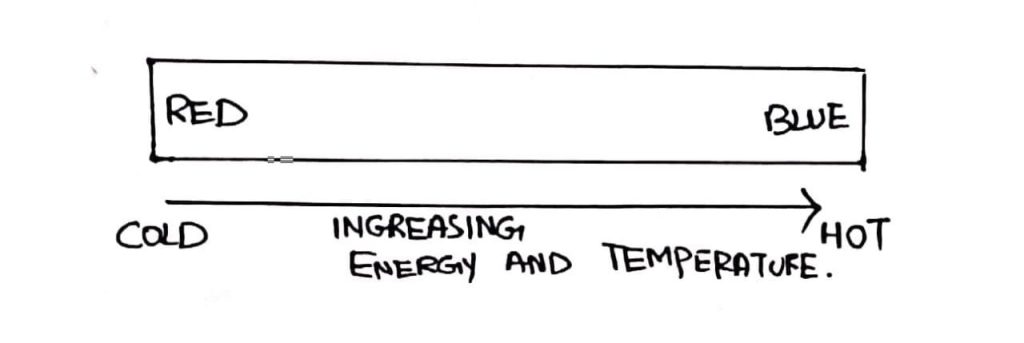
(B) Semiconductors are the Brains of Modern Electronics: Explain in detail what this quotation means.
Question Breakdown:
In this question, the examiner requires you to elaborate the significance semiconductors hold in the modern day electronics. So, what you have to do is to mention the uses of semiconductors in various items of daily use, specifically focusing on the “how” aspect of the working of semiconductors. Remember, writing too much will never reward you highest marks; what awards you maximum marks is to address what is asked. Lastly, in the GSA paper, creativity is the key to make you stand out from other aspirants.
Answer:
Semiconductors:
Semiconductors are the type of material that has electrical resistance between the resistance of metals (conductors) and the resistance of insulators, as the name indicates “semi-conductor”. It is sometimes referred to as an integrated circuit or microchip made from pure elements like silicon and germanium or compounds like gallium and arsenide.
Semi-conductors in modern electronics:
It is a matter of fact that semiconductors are critical components of millions of electronic devices used in computing, telecommunication, household appliances, banking, security, healthcare, transportation, and manufacturing, etc.
- Computing
Microchips, as used in computers, became the first modern means of computation. Depending on the type of chip, a semiconductor uses binary codes to launch a program or download and save a document.
- Telecommunication
The principle of semiconductors for telecommunication is the same as in computing. A smartphone’s semiconductor chips affect its display, navigation, battery use, 4G reception, and a lot more features. Not just mobile phones, all modern means of communication use semiconductors to function.
- Household appliances
Refrigerators, microwave ovens, washing machines, air conditioners, and other machines around homes and offices operate properly, thanks to semiconductors, in which different chips control temperature, timer, and other automated features.
- Banking
Considering the banking sector, banks are the major investors in microchips as banks deal with digital accounting, cloud platforms, cash withdrawal via ATMs, security cameras, and even automated locking mechanisms.
- Healthcare
Medical professionals, nowadays, make use of advanced technology (semiconductor-based) while carrying out complex surgical procedures, like heart surgeries or organ transplants for accuracy, precision, and safety. Even having discussions with patients, getting their history, and diagnosing them is possible via video conferencing.
In short, semiconductors have, undoubtedly, revolutionized modern electronics and, thus, the way we live.
(C) Briefly describe the most popular and accepted theory about the origin of the Universe
Question Breakdown:
In this question, the examiner has asked you to describe the most accepted theory about the origin of the universe. Thus, you need to focus mainly on writing all about the Big Bang Theory with a proper definition and its steps. Remember, writing too much about other theories would have a negative impact on the examiner. However, just eluding the evidence of it in the context of “Why Big Bang is the most accepted theory” and drawing a neat diagram and flow chart can help you get maximum marks.
Answer:
There are a number of theories and hypotheses that tried to explain the origin of the universe. However, the most accepted among all is “The Expanding Universe Theory” or “Big Bang Theory” formulated by Georges Lemaitre, a well-known mathematician, and astronomer of his time.
Big Bang Expansion Theory:
According to the Big Bang Theory, the universe is a result of an expansion and is continually expanding.
The theory states the following points:
- Singularity:
Before the creation of anything, there was present a singularity. Singularity means that our Universe was a very dense and hot single point and time and space were zero. Similarly, the matter and energy had same state and temperature was 10 bn. centigrade. Further, gravity was the dominant energy at that time.
- Expansion:
About 13.5 billion years ago, some force suddenly expanded the singularity, resulting in the evolution of time and space. As the space started to expand, the temperature started to cool down gradually as a result of which the energy was converted into the Quarks- the first particle of matter to be formed.
- Formation:
Eventually, the Quarks started making groups and created different sub-atomic particles, which then formed atoms, elements, and molecules in the form of larger chunks. As gravity was present, it converted these irregular chunks into round and elliptical shaped galactic content that, ultimately, lead to the creation of the galaxies, solar systems, planets, etc. This is the universe we see today. The universe is still expanding at an accelerated rate.
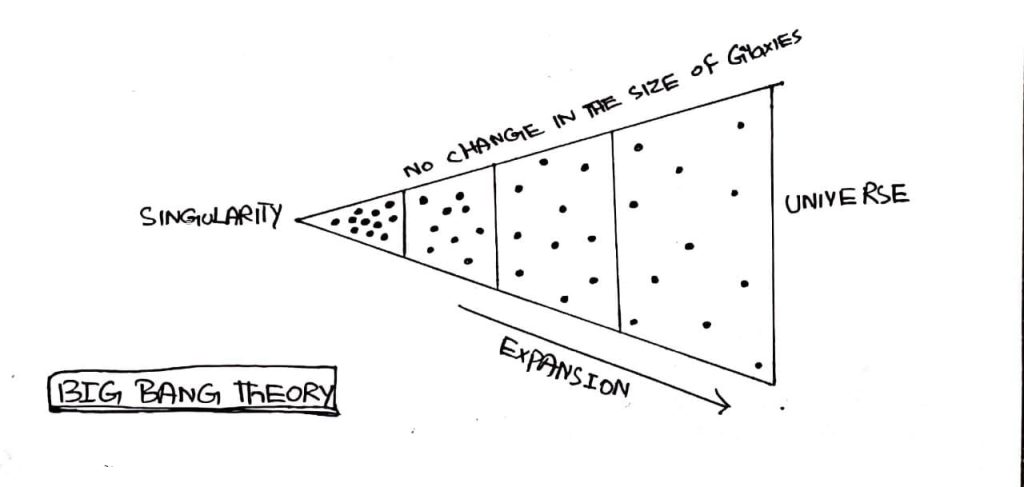
Evidence of Big Bang Theory:
Hubble’s Law provides scientific reasoning to the Big Bang Theory and provides the basis for its authenticity. The law explains that the galaxies are continuously expanding without affecting the size of galaxies. Additionally, the presence of cosmic background radiation also supports the theory.
(D) What are the advantages and limitations of renewable energy resources? Briefly explain the prospects of non-conventional energy resources in Pakistan.
Question Breakdown:
The question consists of two parts. In the first part, the examiner has asked you to explain the advantages and limitations of renewable energy resources. Remember, in solving such questions, always start your answer by defining the term. Hence, you are supposed to define renewable energy with a few examples at first; then, address three advantages and three limitations. In the second part, write the prospects of the renewable/ non-conventional energy resources in bullets to address the question efficiently.
Answer:
Renewable Energy Resources:
As the name explains, renewable energy resources are the sources that are continuously replenished. These sources of energy include solar energy, wind energy, geothermal energy, and hydroelectric power. Following are some advantages and limitations of renewable energy resources:
Advantages of Renewable sources of energy:
- These sources are naturally occurring; therefore, they replenish naturally.
- They are clean to use as they do not emit carbon and greenhouse gases. Consequently, they minimize global warming and protect our environment.
- The installation of renewable energy plants creates lot of employment opportunities.
Limitations of Renewable sources of energy:
- The installation of renewable energy plants is expensive and acquires a lot of resources.
- The power generation from these sources depends greatly on geographical locations and weather conditions.
- The storage cost of these energy sources is very high.
Prospects of Non-Conventional Sources in Pakistan:
Pakistan is a country rich in alternative sources of energy and has great potential of non-conventional energy sources. Some of the prospects of non-conventional energy sources are discussed below.
- Wind Energy:
Wind is an abundant resource in Pakistan. Since the country has several well-known wind corridors and an average wind speed of 7.87 m/s in 10 percent of its windiest areas, the country still has a potential installable capacity of around 346,000 MW.
- Solar energy:
Pakistan has tremendous potential to generate solar energy. According to the World Bank, the country can fulfill its current electricity demand by utilizing just 0.071 percent of the country’s area for solar voltaic power generation. Moreover, it can generate more than 2,900 gigawatts of solar power capacity.
- Biomass:
A large amount of solid waste is wasted every year due to improper solid waste management. However, if Pakistan properly manages its solid waste and animal dump, a large amount of biomass can be produced. According to estimation, the potential of biomass energy in Pakistan is 50,000 GW h/year.
Do you know on a yearly basis nearly 30 to 40 thousands aspirants fail to join Govt. of Pakistan just because of poor English. Let’s give it a read

Question – 03
(A) Explain with examples the relationship between cells, tissues, and organs.
Question Breakdown:
The question consists of two parts. In the first part, the examiner has asked you to explain the relationship between cells, tissues, and organs, and then, you are required to give relevant examples that elaborate the aforementioned relationship. Remember, writing too much will never reward you highest marks; what awards you maximum marks is to address what is asked. Lastly, in the GSA paper, creativity is the key to make you stand out from other aspirants.
Answer:
Understanding Cells, Tissues, and Organs and their Relationship
Cells are the simplest units of life that are capable of performing biological functions, and similar types of cells performing a similar function combine to form a tissue. Eventually, the tissues performing similar actions make up an organ.
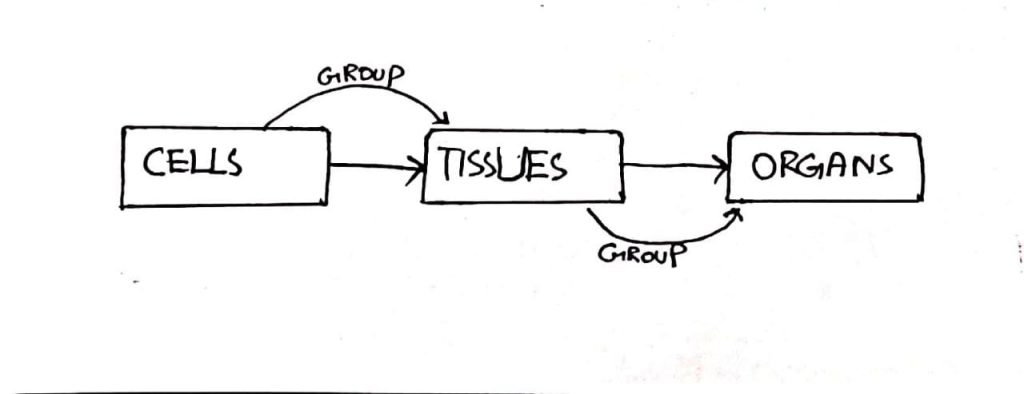
Examples to Illustrate the Relationship:
- Muscles:
- Muscle cells, known as muscle fibers, are the basic building block of muscles.
- The two types of muscle cells are skeletal, cardiac, and smooth.
- Different muscle cells combine to form muscle tissues that keep the body upright, move it, and pump the heart.
- Cardiac, skeletal, and smooth muscle tissues form cardiac, skeletal, and smooth muscles (organs) forming the muscular system.
- Brain and the Spinal Cord:
- Neurons and glia are the basic functional units of the nervous system.
- The neurons and glia combined to form nervous tissues.
- Nervous tissues, muscle tissues, and other tissues to form the Brain and Spinal Cord, which together constitute the nervous system.
- Heart:
- Cardiac, smooth, endothelial, and connective cells are the basic unit of cardiovascular organs.
- These cells combine to form cardiac tissues, smooth tissues, endothelial, connective tissues.
- Different cardiac, smooth, endothelial, and connective tissues help heart to function properly.

(B) Explain the difference in structure & function between a cell wall and a cell membrane.
Question Breakdown:
In this question, the examiner has asked you to differentiate cell wall and cell membrane-two components of a cell- on the basis of two main characteristics, i.e., structure and function. Solving the question in the tabular form can help you make your answer more presentable and distinguished. Thus, you have to draw a table with three columns with first column dealing with the names of characteristics and other two columns explaining cell wall and cell membrane in bullets form respectively. In this question, you do not need to draw any diagram.
Answer:
| Cell wall | Cell Membrane |
| Structure of a cell wall | Structure of a cell membrane |
| The outermost layer of the plant cell is called the cell wall. | The outermost layer of the animal cell is called the cell membrane. |
| It is present only in plant cells. | It is present in all types of cells. |
| The cell wall has a thick and rigid structure with a fixed shape. | The cell membrane has a thin and delicate structure with a fixed shape. |
| Pectin, cellulose, and hemicellulose from the cell wall. | It is made up of 4 types of molecules: proteins, carbohydrates, cholesterol, and phospholipids. |
| It is made up of 35% pectin, 30% cellulose, 30% hemicellulose, and 5% protein. | It is made up of 60-80% protein and 20-40% fat. |
| The cell wall is o.1 um thick. | It is 7.5- 10 nm thick. |
| Functions of a cell wall | Functions of a cell membrane |
| It maintains the shape of the cell. | It maintains the shape of the cell. |
| The regulation of the transfer of material into and out of the cell is controlled by a cell wall. | It plays role in the transportation of things into and out of the cell. |
| It provides protection to the cell and separates it from its surrounding environment. | It provides internal protection to the cell from the external environment. |
| It is fully permeable. | It is the porous membrane; however, it is selectively permeable allowing selective cells to pass into and pass out of the cell. |
(C) What is meant by transpiration? Explain in detail the significance of leaf structure in the process of transpiration.
Question Breakdown
This question is quite simple. First, the examiner has asked you to explain the understanding of transpiration in your own words. Next part of the question demands the role of leaf structure-stomata- in the process of transpiration. Remember, never attempt any procedural question without diagram; otherwise, it could affect your efficiency. Lastly, in the GSA paper, creativity is the key to make yourself stand out from other aspirants.
Answer:
Transpiration:
Transpiration is the biological process by which the excessive water is evaporated from the surface of leaves of plants into the atmosphere in the form of moisture and water vapors.

Role of leaves structure in Transpiration:
Plant leaves have the tiny pores on their epidermal surface that play a significant role in transpiration. These special pores are called stomata. Stomata are microscopic parts consisting of two kidney shaped guard cells. As soon as the water absorbed by the roots reaches the tissues of the leaves through veins, the spongy surface of mesophylls is responsible for taking this water to stomata. Moreover, the 90% of transpiration in plants takes place through stomatal transpiration. In stomatal transpiration, water vapors move through stomata of leaf as the guard cells open and close respectively.
Opening and closing of stomata:
The opening and closing of stomata depend on the turgid or flaccid state of guard cells. In the flaccid state of guard cells, stomata are closed. In turgid state, they are open. Consequently, transpiration occurs when the stomata are open, and it stops when they are closed. Moreover, during daytime, transpiration is more because guard cells are swollen. This swelling caused by the higher concentration of carbohydrates resulting from photosynthesis provides greater area for the release of water. On the other hand, during night time, the guard cells are shrunk providing less area for the release of water.
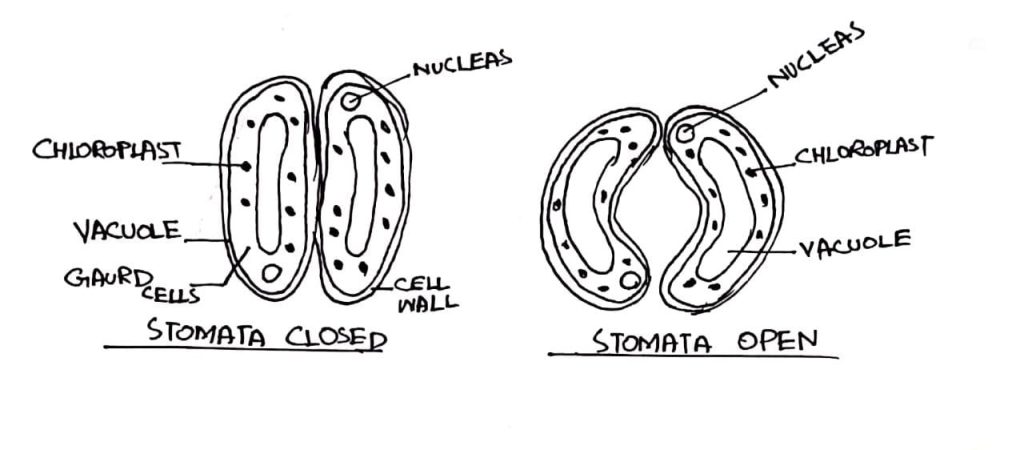
(D) What is meant by the term double circulation? Briefly describe how the heart is adapted to keep blood flowing in a double circulation.
Question Breakdown:
The question consists of two parts. In the first part, the examiner has asked you to elaborate the term “double circulation”. Next, he has asked you to explain concisely the way the heart functions to perform double circulation, i.e. the mechanism and components of the circulatory system involved in the process. Remember, writing too much will never reward you highest marks; what awards you maximum marks is to address what is asked. Lastly, in the GSA paper, creativity is the key to make you stand out from other aspirants.
Answer:
What is double circulation?
The heart has two sides from which the blood flows in and out twice per circuit. This circulation of blood twice per circuit is called double circulation. The right side of the heart pumps the deoxygenated blood from the body into the lungs. On the other hand, the left side of the heart pumps the oxygenated blood from the lungs into the body.
Brief description of the blood flow in heart
As there are two sides in the heart, each side is divided into two atria (upper chambers) and two ventricles (lower chambers).
- The venae cava, the largest vein in the body, carries deoxygenated blood from the body into the right atrium. From the right atrium, the blood goes into the right ventricle through the tricuspid valve from where it further goes into the lungs.
- Now, the lungs oxygenate the blood and take it into the left atrium. From the left atrium, oxygenated blood flows into the left ventricle through the bicuspid valve. Afterwards, blood flows from the left ventricle into the body, and aorta, the largest artery of the body, supplies it to the whole body.
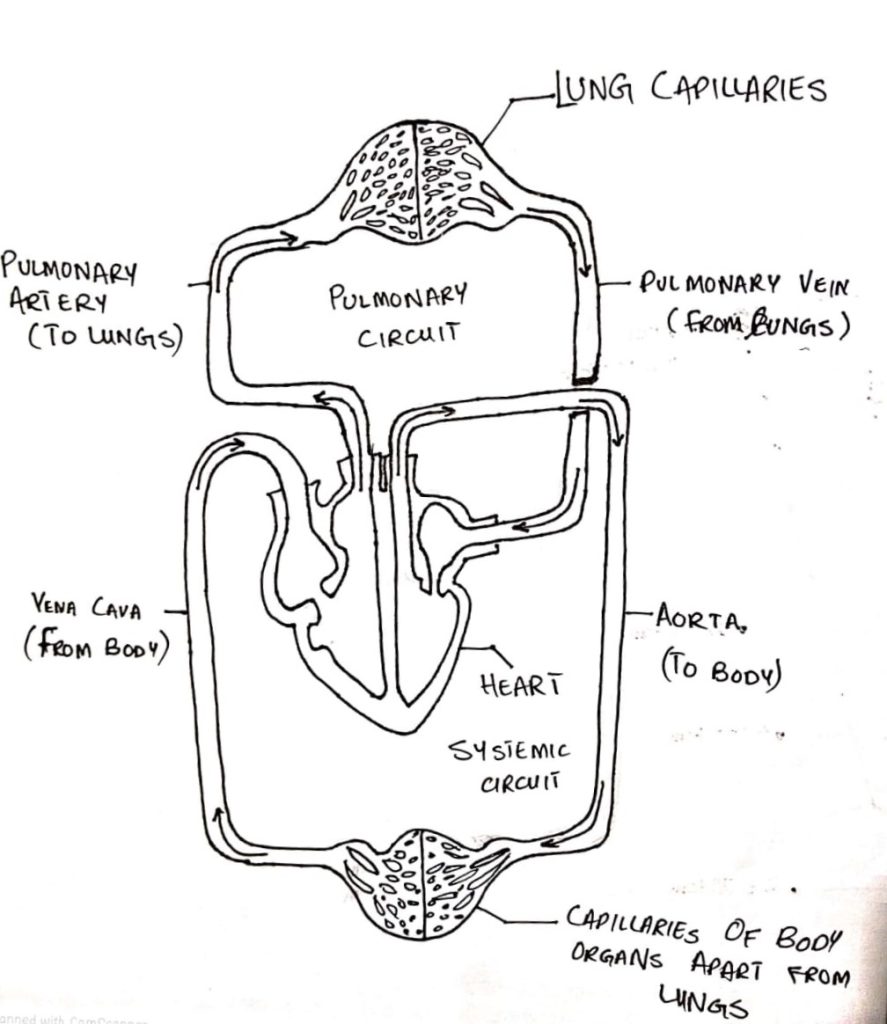
Consequently, double circulation in right and left side of the heart takes place simultaneously.
Question – 04
(A) What is the sequence of strata of the atmosphere and on what factors does it depends?
Question Breakdown:
In this question, since the examiner has asked you to describe the strata of atmosphere, initiate the answer with explaining atmosphere briefly in your own words. When done, write down the layers of the atmosphere in the bullet form and a to the point description. Remember, writing too much will not help you secure good marks in any way. Next, write all the possible factors on the basis of which the layers vary, for instance, temperature, width, density, etc. using headings and bullets. Lastly, in the GSA paper, creativity is the key to make yourself stand out from other aspirants. Therefore, add a schematic diagram illustrating the layers of atmosphere.
Answers:
What is Atmosphere?
The layers of gases around the earth are called the Atmosphere. In other words, an atmosphere contains the air that we breathe and is a blanket of gases that surrounds Earth. Moreover, it is held near the surface of the planet by Earth’s gravitational attraction.
Strata of Atmosphere:
The atmosphere is comprised of five distinct layers that are determined by the changes in temperature that occurs because of increasing altitude.
- Troposphere: The bottom-most layer of the atmosphere where we live in the troposphere. It extends upward to about 10km above sea level starting from the ground level. It comprises of 75% of all air in the atmosphere; its lowest part is known as the boundary layer while the topmost layer is called the tropopause.
- Stratosphere: Above the troposphere lies the stratosphere. Its distance from the surface of the earth is 12 -50 Km. the ozone layer lies in the stratosphere; the stratosphere is the layer where airplanes fly.
- Mesosphere: The layer of ions is Mesosphere. It extends to a height of about 85km from the ground level.
- Thermosphere: The topmost layer of the strata of the atmosphere is the thermosphere. Its distance from the earth’s surface is 80-320 Km. Satellites orbit Earth within the thermosphere.
- Exosphere: The pseudo or false atmosphere above 500 km is the exosphere. It is the final frontier of the Earth’s gaseous envelope. The exosphere is 10, 000 km from the earth’s surface. However, there’s no clearcut upper boundary where it finally fades away into the space.
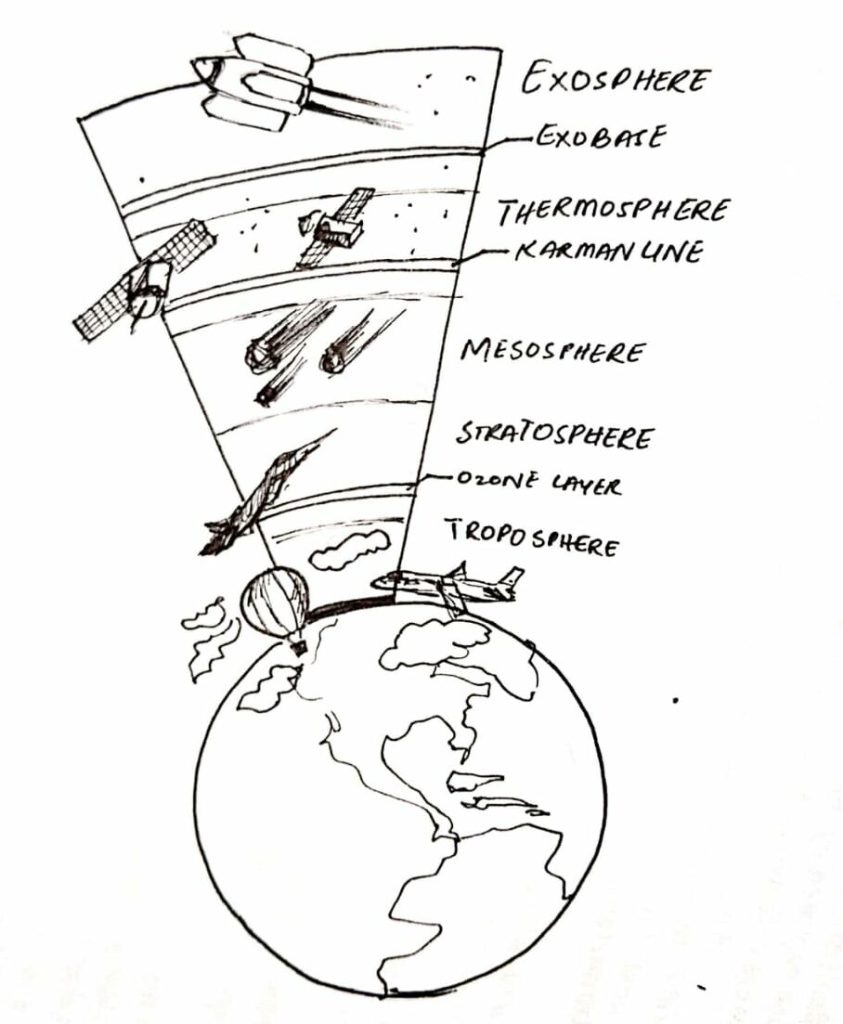
Factors affecting the composition of the atmosphere:
The atmosphere is divided into the above layers based on following factors:
- Temperature and Altitude of the layer
| Temperature and Altitude | |
| Troposphere | The temperature starts dropping as one goes higher in the troposphere. In the troposphere, temperature drops by 6.5 Celsius degrees per kilometer. |
| Stratosphere | Since the ozone layer comes under the stratosphere, the ozone molecules absorb ultraviolet (UV) rays from the sun and convert them into heat; consequently, the temperature of the layer increases. |
| Mesosphere: | The temperature again decreases with increasing height. This is coldest parts of our atmosphere are located here and can reach around about -90 degrees Celsius. |
| Thermosphere | The presence of ultraviolet rays and ions (excited atoms) increases the temperature of the layer. Temperatures in the upper part of the thermosphere range from 500 degrees Celsius to 2000 degrees Celsius or even higher. |
- Gravity and Pressure in the layer
Another factor that affects the sequence of strata is pressure and gravity. Gravity pulls the molecules in the air towards the earth exerting pressure on molecules. The pressure causes molecules to behave in a specific way. When a parcel of air moves upwards, it expands, and when air expands it gets colder.
- Chemical Composition of the layer
The chemical composition of the layer is also another major factor, which in some ways is affected by the gravity, temperature, and pressure in the respective layers.
(B) Describe the water cycle and briefly explain the major processes involved in the water cycle?
Question Breakdown:
The question consists of two parts. In the first part, the examiner has asked you to define the water cycle. Then, you have to delineate the processes that make up the whole water cycle. Remember, writing too much will never reward you highest marks; what awards you maximum marks is to address what is asked. Lastly, in the GSA paper, creativity is the key to making yourself stand out from other aspirants; thus, draw the water cycle and label it properly to score maximum marks.
Answer:
What is a water cycle?
The water cycle, also known as the hydrological cycle, describes how the water is exchanged through evaporation from the surface of Earth, rises into the atmosphere, gets colder, and then condenses into raindrops, and, at last, falls back to Earth’s surface as precipitation. It is a continuous cycle that preserves the availability of water on earth. Moreover, this precipitation of water in and out of the atmosphere is a notable aspect of the weather patterns on Earth. Lastly, the water cycle is powered by solar energy and gravity.
Of the many processes involved in the water cycle, the most important ones are Evaporation, evapotranspiration, condensation, precipitation, runoff, and reabsorption.
- Evaporation: Evaporation is one of the major processes in the cycle. Here, the water is converted into gaseous water vapors that occur when the water molecules have attained a sufficient amount of kinetic energy which helps them to eject themselves from the water surface. By evaporation, during the water cycle, all the water from earthly water bodies like seas, oceans, rivers, streams, and lakes in the form of water vapors go into the atmosphere. Factors that are mainly involved in this process are temperature, humidity, wind speed, and solar radiation. Moreover, the statistics show that 90% of water vapors in the atmosphere are formed by evaporation.
- Evapotranspiration: The evaporation of water in the form of water vapors from the bodies of living organisms, like animals and plants, is called evapotranspiration. From plants, water is released through minute pores or stromata present in leaves by a process called transpiration, and from animals, it is released in the process of sweating. The statistics show that 10% of water vapors in the atmosphere are formed by evapotranspiration. Moreover, almost all the water vapors are confined to the troposphere -the bottom-most layer of the atmosphere.
- Condensation: The transition process in which gaseous vapors are converted into liquid or solid is known as condensation. During the water cycle, as water vapors start moving upwards, they start to condense in form of clouds, dew, fog, and frost. They are called the product of condensation. By condensation, water vapors in the atmosphere are released to form precipitates.
- Precipitation: When the product of condensation, such as clouds, falls towards Earth’s surface in large bulk in the form of precipitates, this whole process is called precipitation. It is, then, distributed in four main ways:
- Some of its parts return to the atmosphere by the process of evaporation
- Some may percolate into the soil through the process of infiltration
- Some of its parts may intercept by the process of vegetation which is then evaporated from the leaves’ surface
- Some flow directly as surface runoff into the sea
- Lastly, during the water cycle, since clouds have been formed, they fall to the ground in the form of rain, snow, sleet, and hail.
- Surface Runoff: It is basically the flow of water that occurs on the ground surface when the water from rain, snow, and hail starts moving from greater heights towards the lower areas, and can no longer infiltrate in the soil rapidly. In other words, water that flows from higher to lower levels and finally into oceans instead of getting absorbed into the soil is what we know as surface runoff. For example, rivers, streams, seas, lakes, etc. Moreover, the geomorphological factors involved in this process include the type of soil, area, shape, slope, and network of drainages.
- Infiltration: During surface runoff, some water is infused into subsurface soils, making underground water reservoirs. This process is called infiltration in the water cycle. The result of infiltration is water tables and aquifers. If the aquifers are porous enough that they allow the water to move freely through them, wells can be drilled into the aquifers.
- Re-absorption of water: Plants and animals absorb the underground water that again goes into the atmosphere through evapotranspiration.
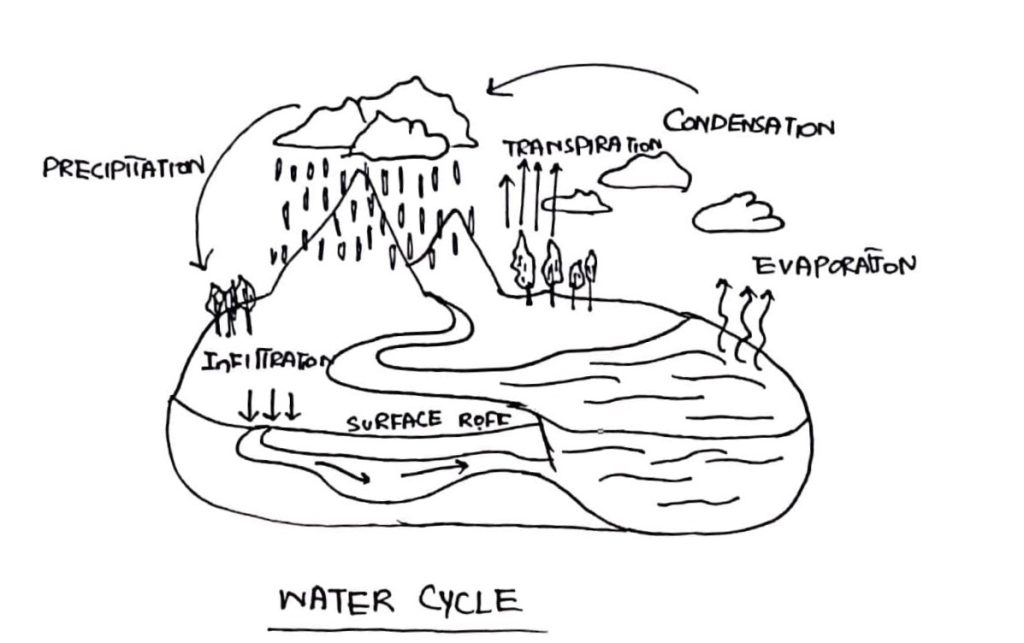
(C) What is the difference between asthenosphere and lithosphere? Explain various components of the lithosphere.
Question Breakdown:
In this question, the examiner has asked you to differentiate asthenosphere and lithosphere- the two mechanical layers of the earth’s interior. Thus, answer the question by simply drawing the table of differences between both. Try to write the clear differentiating points in bullet form. In the next part, the examiner has asked you to explain the various component of the lithosphere. Lastly, Draw a diagram and label it properly to gain maximum marks in your examination.
Answer:
| Lithosphere | Asthenosphere |
| The lithosphere consists of the earth’s crust and the uppermost solid layer of the mantle. | The layer of earth where the magma in liquid form is present is called Aesthonosphere. |
| The Continental crust lies above the lithosphere. It overlies the aesthenosphere. | The lithosphere lies above the aesthenosphere. |
| It has a depth of 100 km with 70 km upper mantle and 30 km crust. | It has a depth of 600 km. |
| As this layer consists of the tectonic plates, that’s why it is rigid and brittle in nature. It tends to break and does not flow. | As it is a weak and easily deformed layer, this layer, therefore, acts as a lubricant for the plate tectonics to slide over. It tends to flow like toothpaste. |
| It consists of different elements and minerals. | Since it is molten lava and magma, it contains only iron-magnesium silicate. |
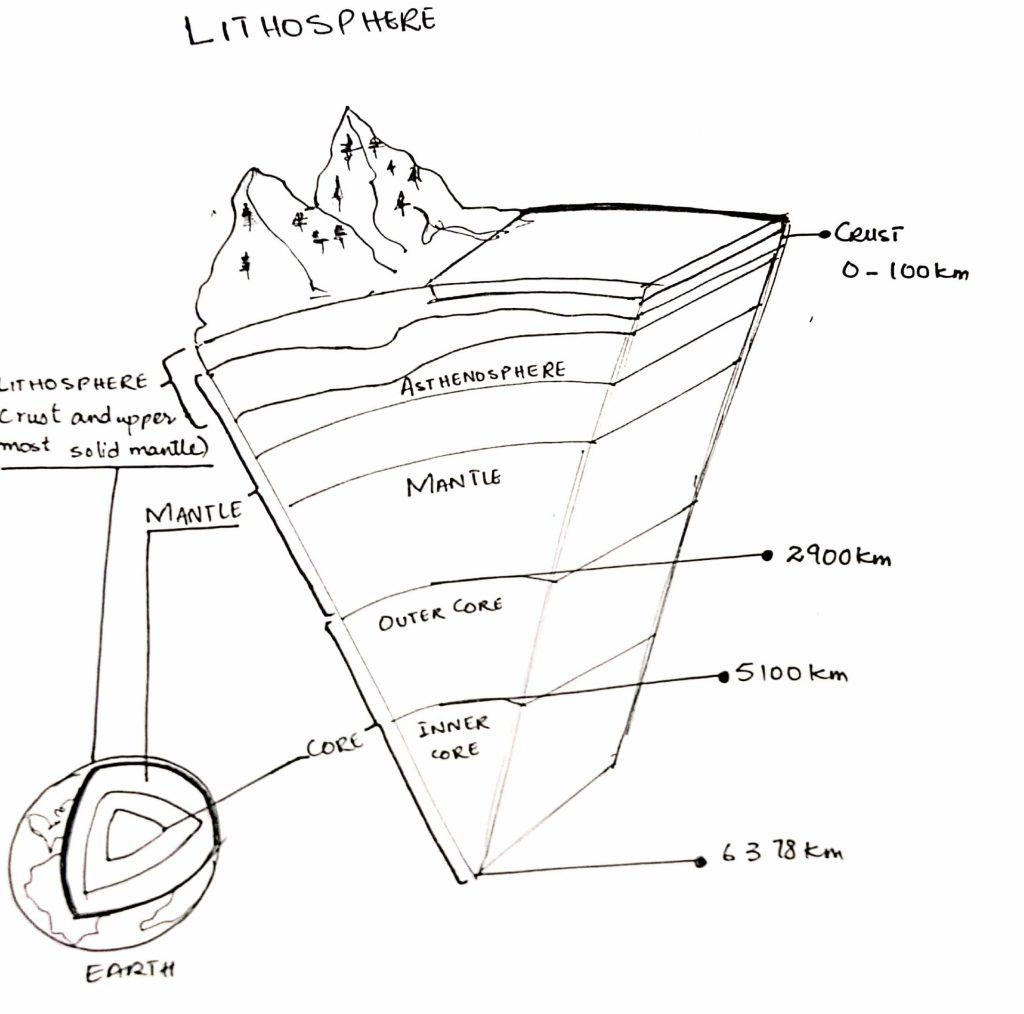
Components of the lithosphere:
The lithosphere, the rigid and outermost shell of the earth, is essentially comprised of two main elements:
- Crust:
- The lithosphere contains crust which is its lightest, most buoyant layer. It further comprises of continental and oceanic crust.
- The Continental crust is significantly thicker (20 to 80 km) than the oceanic one (5 to 10km) and its upper part is more exposed as compared to its lower part. It is comprised of granite rock that is lighter in color. It mainly constitutes silicon, aluminum, and oxygen.
- Oceanic crust is that part of the Earth’s crust that comprises dark-colored rocks which are made up of silicon, oxygen, and magnesium. Moreover, it scarcely floats on the mantle.
- The upper and lower mantle
- The upper mantle is located beneath the crust of the Earth and ends at the lower mantle. It is responsible for the movement of tectonic plates, earthquakes, and volcanoes. Its thickness is round about 200 to 250 miles. Here, the temperature ranges from 900 to 1600 degrees Fahrenheit. The upper mantle is not homogenous throughout. Its lowest layer of the upper mantle is known as the aesthenosphere which comprises of fluid and is able to move. This fluidity causes the tectonic plates to move.
- The lower mantle is located approximately 400 to 1800 miles below the earth’s surface. It makes up the most bulk of the entire mantle. It contains solid rock and minerals. It is located above the outer core. Additionally, the lower mantle is extremely hot around about 7000 degrees Farenheit because it helps in transferring heat from the core to the upper mantle.
This part of lithosphere, as a whole, is about 1800 miles thick. The magma in its solidified form is present in Lithosphere. Moreover, to scientists, the mantle is a crucial part of the interior of earth.
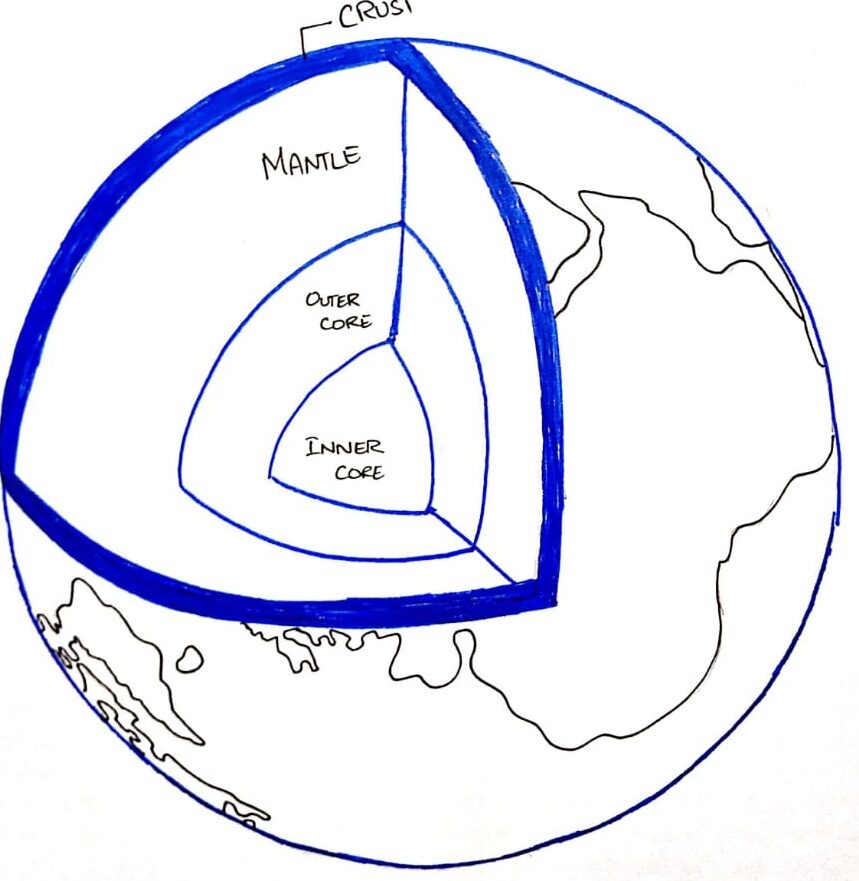
(D) Differentiate between food contaminants and food adulterants.
Question Breakdown:
In this question, the examiner has simply asked you to differentiate between food contaminants and food adulterants. So, you need to write down the maximum differences between the two of the terms. First of all, start the first point by defining both the terms. Additionally, adding examples for both of the terms to elaborate them is what will award you maximum marks. Finally, making a table to differentiate the two is what would make your paper standout from other aspirants. Lastly, there’s no need to draw any sort of diagram in this question.
Answers:
| Food contaminants | Food adulterants |
| Definition: Food contaminants are unwanted and impure elements in food, mainly introduced by the environment through humidity, heat, water contents, or soil etc. Moreover, they also include any harmful substances that are unintentionally added to food, which maybe chemicals from natural resources or formed during food processing. | Definition: Food adulterants are inferior, substandard, or unnecessary substances deliberately added to food to improve its appearance and to gain greater profit. |
| Examples: Heavy metals in soil, which plants take up, are present in vegetables and fruits as food contaminants. Similarly, exposing food to high temperature provides a favorable environment for pathogens and bacteria to grow, ultimately contaminating the food. If the fields are sprayed with contaminated water for irrigation, fruits and vegetables can be contaminated before harvesting. | Examples: A chemical named melamine is commercially added to milk to increase its protein level. Tea leaves are usually adulterated with used tea leaves that are processed and colored. To enhance the flavor and color of honey, companies mix molasses sugar with it. Injecting water or brine into meat to increase its weight is also an example of food adulteration. |
| In most of the cases, containment of food happens naturally. | Adulteration of food is completely a man-made process. |
| Food containment is an unintentional process. | Food adulteration is done intentionally. |
| It does not have any economic gains. | It is motivated by economic gains. |

Question – 05
(A) Define the term “malnutrition: Elaborate its major causes and consequences.
Question Breakdown:
There are three parts of this question. In this first part, the examiner has simply asked you to define the term malnutrition. Therefore, start with defining the term briefly in your own words. When done, write down the main causes of malnutrition in bullets, which is the second part of this question. Moreover, write down the major consequences of malnutrition that too in bullet points. Remember, making headings, subheadings, and bullets is what will award you maximum marks in your paper. Lastly, you are not supposed to draw any diagram in this question.
Answers:
Definition of Malnutrition
Malnutrition, in all its forms, refers to the deficiency, excess, or imbalance of the nutrients in a person’s diet. The term is used to refer poor nutrition and overnutrition. However, it commonly refers to undernutrition, a condition when a person does not intake right number of dietary intakes -a condition when the body is deprived of vitamins, minerals, and other nutrients that are significant to maintain the tissues, cells, and bones healthy.
Major causes of Malnutrition
There are various factors that can lead to malnutrition:
- Acquired Causes: In this case, a quantitatively inadequate diet, mainly in calories or protein, is the main factor behind malnutrition. I.e.,
- Unavailability of sufficient food
- Inadequate agricultural processes
- Imperfect distribution of food
- Malabsorption of vitamins, such as A, K, and D, minerals, and nutrients
- Poor eating habits and food preferences
- Role of metabolic defects:
Malnutrition can also arise from acquired or inherited metabolic defects, notably those involving the digestive tract, liver, kidney, and red blood cells, etc.
Consequences of malnutrition
- Social consequences
- Child malnutrition: Undernourished children have weak immune systems; therefore, they are prone to many diseases, like diarrhea, anemia, stunting, rickets, etc.
- Adult malnutrition: Improper intake of nutrients badly affects an adult’s weight, height, eyesight, health, and other mental capabilities.
- Economic consequences
- Malnutrition slows economic growth and perpetuates poverty.
- Morbidity and mortality due to malnutrition cause loss in human capital and productivity.
(B) Explain how a slice of bread after few days decomposes due to the growth of fungi.
Question Breakdown:
In this question, the examiner has asked you to elaborate the reason why a slice of bread gets decomposed because of fungal growth. Here, first of all, you will describe which fungus is responsible for the decomposition of the bread. When done, you are supposed to elaborate that how this fungus causes the decomposition of bread slice. Moreover, elaborating the factors which accelerate the growth of mold at the end of your answer in bullets is what will award you maximum marks. Lastly, there’s no need to draw any diagram in this question.
Answers:
A fungus called bread mold is responsible for the bread decomposition. When bread is kept in warm temperature for a few days, mold grows on bread.
How does mold decompose the bread?
Since there are tiny spores present in the air, they fall on the slice of bread and the mold starts to grow. These spores germinate to form hyphae that release secretive enzymes on the particles of bread and break them down into smaller pieces. Afterward, mold absorbs the moisture and nutrients from the bread and starts to spread throughout the bread decomposing the bread.
Factors accelerating the growth of mold
- Temperature:
Temperature is the most important factor determining the growth of mold. It grows faster in warm temperatures; therefore, it can be prevented by keeping the bread in the refrigerator. - Moisture:
Moist bread is likely to decompose faster. - Acidity:
Mold grows more in acidic foods. Bread with a higher ph value is less likely to decompose. If the pH value is less than 7, mold grows faster.
(C) What is computer memory? Describe its units and discuss various types of memories.
Question Breakdown:
This question has three parts. In the first part, the examiner has asked you to describe computer memory in your own words. Remember, elaborating too much about the term will never reward you good marks being relevant to the term are what will award you maximum marks. When done, describe its units, which is the second part of the question. Before describing its units, try to define what a memory unit actually means. Lastly, write down the types of computer memory, which is the third and last part of this question.
Answers:
What is computer memory?
Computer memory is the storage space where the computer stores data, instructions, and programs. These memory spaces keep the data that is to be processed and the instructions required for processing. Moreover, a computer stores the data in specific locations with unique memory addresses.
Computer Memory Units
The units that represent how much data can be stored in a computer are called memory units. Following are some of the memory units:
- Bit: it is the smallest memory unit that stores two digits 0 and 1.
- Byte: 8 bits make one byte. However, a byte can store multiple characters, alphabets, digits, etc. it is also a pattern that stores data in numbers between 0 and 255.
- Kilobyte: 1024 bytes makes 1 kilobyte. It stores up to 1000 characters.
- Megabyte: 1024 kilobytes make 1 megabyte. It stores 1 million characters.
- Gigabyte: 1024 megabytes make 1 gigabyte. It stores 1 billion characters.
- Terabyte: 1024 gigabytes make 1 terabyte. It stores 1 trillion characters.
Types of computer memory:
There are various types of computer memory: Cache Memory, Primary Memory, and Secondary Memory.
- Cache Memory
The memory that acts as a buffer between CPU and main memory is called cache memory. The programs that are most frequently used by CPU are kept in this memory. Therefore, it increases the speed of the CPU.
- Primary Memory (Main Memory)
Primary memory holds the data and instructions on which a computer is currently working. They are volatile memories since data is lost when the computer is switched off. RAM and ROM are examples of main memory.
- Secondary memory
The external or non-volatile memory of a computer is called secondary memory. The data and instructions are permanently stored in them. Also, CPU does not directly access them; instead, they are accessed through input-output devices. DVD, CD-ROOM, USB, is some examples of secondary memory.
(D) Differentiate between natural and artificial satellites. Briefly describe the working of communication satellites with some applications.
Question Breakdown:
The question has three parts. In the first part of this question, the examiner has asked to differentiate between the two terms. So, draw a table and write down the main differences between natural and artificial satellites. Remember, in GSA paper, being relevant to the question is the key. Thus, avoid writing too much about what is being asked. When done, describe the working of a communication satellite with examples. Last, write down the applications of communication satellite using bullet points and subheadings. Finally, in this question, you are not supposed to draw any sort of diagram.
Answer:
| Natural Satellites | Artificial Satellites |
| The satellites that exist naturally in the space are called natural satellites. | The man-made satellites serving human for various tasks are called artificial satellites. |
| Earth’s moon is an example of natural satellites. | The communications satellites created by humans for communication are examples of artificial satellites. |
The working of a communication satellite with examples:
Communication satellites use high-frequency and high-wavelength waves called radio waves to send and receive signals.
Communication satellites have two transmission systems to communicate with earth:
- Uplink: The transmission of signals from earth to the satellite is called uplink
- Downlink: whereas the transmission signals from the satellite to the earth are called downlink.
Moreover, the communication to and from the satellite is done in three steps:
- Sending signals from earth station
- Retransmitting signals from satellites
- Receiving signals on satellite footprint.
Applications of communication satellite
- Television satellite:
To watch a cricket match, live from England in Pakistan, the signals from the earth station, and the stadium, are sent to the television satellite. The satellites receive, interpret, and retransmit the signals to the earth station in the coverage area of Pakistan. The coverage area, known as satellites footprint, includes various television stations in Pakistan that receive signals through antennas and send to television sets in houses. - Radio satellite
Similarly, to listen to a podcast on radio, the signals from radio station are sent to the satellites. Radio satellites receive, interpret, and retransmit the signals to the satellite footprint of the area where the podcast is being heard. Moreover, the frequency of the radio set catches the frequency of radio station through antennas to play the podcast. - Mobile phone satellites.
These satellites work on the same principle of communication satellites. The voice from one mobile tower is sent to the mobile satellite which retransmits the signal to the other mobile tower through antennas.

Question – 06
(A) A man is now 3 times as old as his son. In ten (10) years’ time, the sum of their ages will be 76. How old was the man when his son was born?
Answer:
This question was taken from the Age problem Unit in which we need to find out the age of the father when his son was born that depends upon the son age,
So assume
Age of Son = x
Age of Father = 3x (Man is 3 times as old as his son)
In 10 years’ time, the sum of their ages will be 76.
Now in 10 years’ time
Age of son = x+10
Age of Father = 3x+10
Age of Son + Age of Father = 76 (According to question statement)
(x+10) + (3x+10) = 76
(Now Solve to get the age of son)
x +10 + 3x + 10 = 76
4x + 20 = 76
4x = 76 -20
4x = 56
x = 14 (Age of Son in 10 years’ time)
Now put the son age to get the father age
Age of Father = 3x
= 3(14)
= 42 (Age of Father in 10 years’ time)
Now just subtract the son’s age from father’s age to get the answer.
Age of Father when his son was born = 42 -14 = 28 Years
So, the Father’s age was 28 years when his son was born.
(B) How many tiles of 20cm2 will be required to have a footpath 1m wide carried around the outside of grassy plot 24m long and 14m broad?
Answer:
This question was taken from the Geometry Unit, in which we need to find out the number of tiles for making the footpath 1 meter wide outside around the grassy plot.
According to question grassy plot area
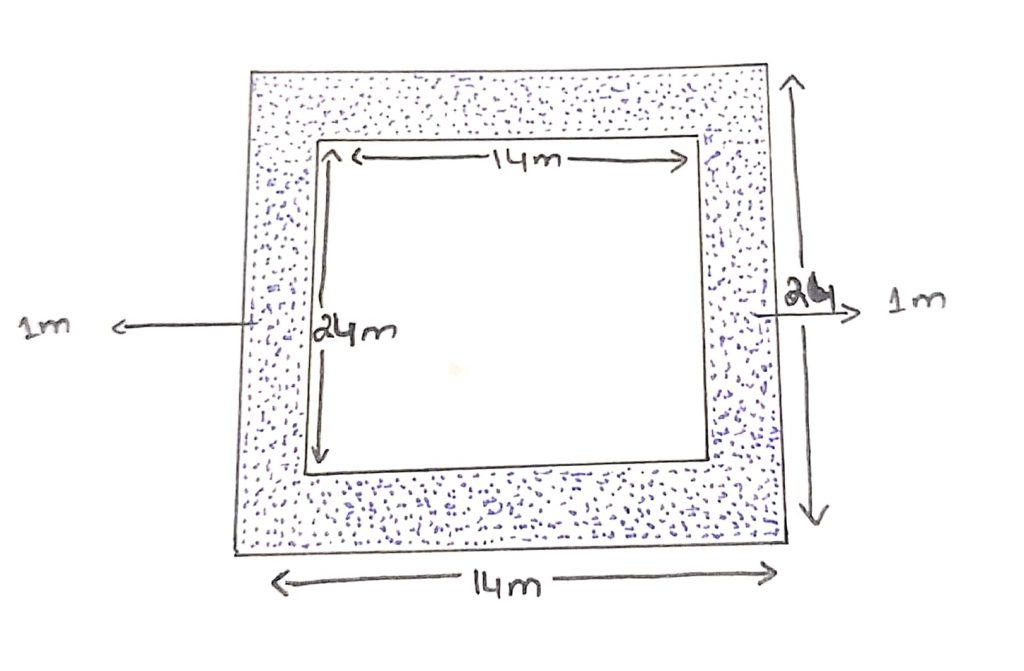
We use the following formula to calculate the area,
Area = Length * Width
So So the area of the grassy plot
= 24 * 14
= 336 m2
Now we need find the total area of grassy plot with footpath
Now calculate the area with a footpath
Area = Length * Width
= 26 * 16
= 416 m2
Now subtract the area of the grassy plot from the area of the grassy plot with a footpath to get the area of a footpath.
= 416 m2 – 336 m2
= 80 m2
Let’s convert the m2 to cm2
80 m2 = 800,000 cm2 (As 1 m2 = 10,000 cm2)
One tile = 20 cm2
Now divide the total area to find out the number of tiles;
Number of tiles = 800,000/20
Number of tiles = 40,000
(C) Mr. Faheem has dinner with his family at a restaurant that offers a 10% discount on food. The marked price of the food that they order was Rs. 15000/- Given that there were service charges of 10% and GST is 17%, calculate the total amount of money he has to pay.
Answer:
From the information given in the question, we conclude that the problem deals with discount, GST, and service charges on the paid amount. So,
Total price after discount is
D. Price= List price x discount rate
= 15000 x 10%
= 15000 x 10/100
= 1500
Total price after discount= 15000-1500
= 13500
Now service charges are 10%
So,
= 13500x 10/100
= 1350
And, GST is 17% so,
= 13500 x 17/100
= 2295
Therefore, the total amount the family needs to pay= 13500 + 1350 + 2295
= 17145
Hence, 17145 is the total amount that the family needs to pay after all the taxes and discount.
(D) Mr. Khawaja walked for 45 minutes at the rate of 3km/h and then ran for half an hour at a certain speed. At the end of that time, he was 6km away from the starting point. How fast did he run?
Answer:
This question was taken from the Time and Distance Unit in which we need to calculate the speed of Mr. Khawaja running
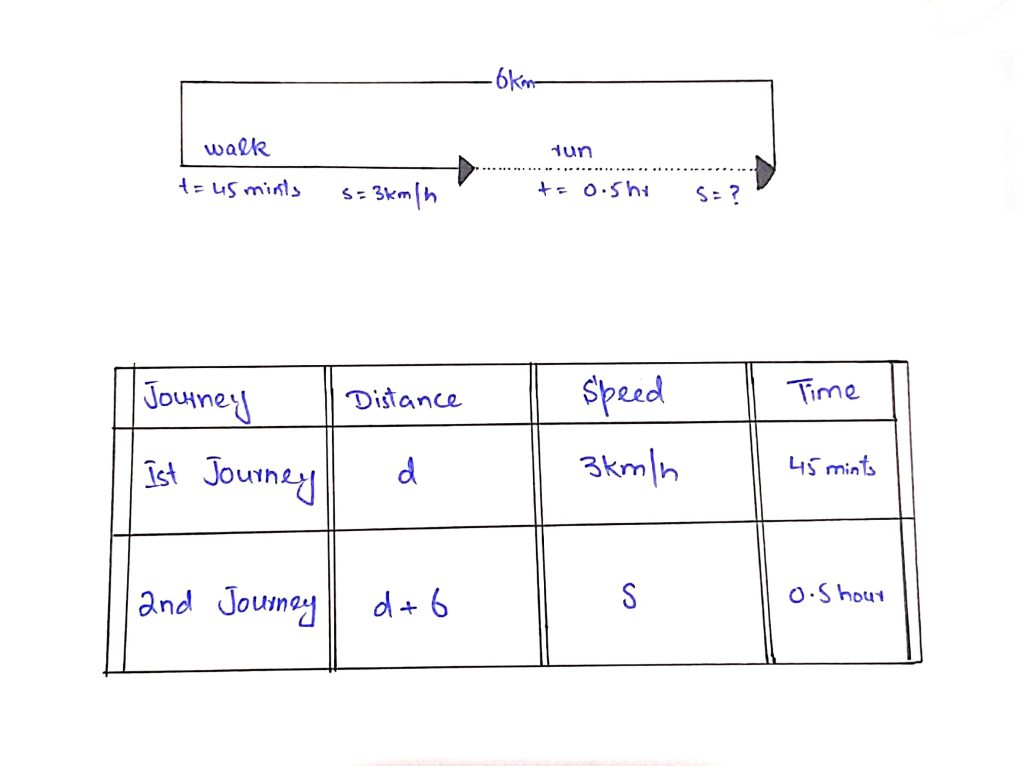
We used the following formula to solve this type of question,
Distance = Speed * Time
In given question, there are 2 part,
- He walked for 45 minutes at a speed of 3km/h. (Find distance covered)
- He runs at a certain speed for half-hour and covers a distance. (Find distance and speed)
So, calculate the distance according to first part by using the above formula,
Distance = Speed * Time
= 3 Km/h * 0.75 h
= 2.25 Km
We need to convert the minutes in hours = 45/60 = 0.75 hour
So in the first 45 minutes, he covers 2.25 km.
Now find the distance cover by him by running as his total covered distance is 6 km.
Distance covered by running = Total distance covered – Distance covered by Walked
= 6 – 2.25
= 3.75 km
As you calculate
Distance = 3.75 km
Time = half hour = 0.5 hours (30min/60 = 0.50)
Solve the 2 part to find the speed of his running,
Distance = Speed * Time
????? = ???????? / ????
Speed = 3.75 / 0.5
Speed = 7.5 Km/h
Writing meaningful sentences, lines, paragraphs, and blogging helps children maintain positivity, sharpen their intellect, and think purposefully. Let’s get your kid(s) registered & turn him a youngest blogger!
Kids Online Writing Course

Question – 07
(A) A child went 90 meters in the east then he turned right and went 20 meters. Subsequently, he turned right and after going 30 meters he reaches his uncles home. From there, he went 100 meters to his north. Determine How far he is from the starting point?
Answer:
This question was taken from the Direction problem Unit in which we required to calculate the distance from the starting point:
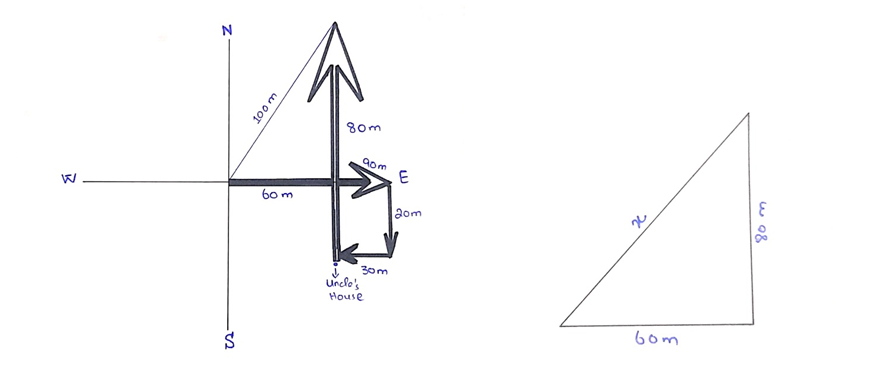
According to the question statement
Point A is the Starting point of the child and point F is the ending and we need to find the distance from point A to F, for this first we find the distance between A to E and E to F,
AE = AB – EB (AB=90 and DC=EB=30)
= 90 m – 30 m = 60 m
Similarly
EF = DF – EF
= 100 m – 20 m = 80 m (DF=100 and BC=DE=20)
Now According to Pythagoras Theorem
(AF)2 = (AE)2 + (EF)2
Put the value of AF and EF as calculated above
Using the Pythagorean theorem
x²= 80² + 60² m
Taking square root on both sides

So, the child is 100m away from his starting point.
(B) The average of 11 numbers is 63, that of first 6 numbers is 60, and that of last 6 numbers is 65, find the 6th number
Answer:
This question was taken from Average Unit in which we required to find the 6th number,
We use following formula to calculate the average;
According to question statement Average of;
11 numbers = 63
First 6 number = 60
Last 6 number = 65
Now we just need to calculate the sum of all number, first and last 6 number, So according to above
formal:
Sum of 11 Numbers = 11 * 63 = 693
Sum of first 6 Numbers = 6 * 60 = 360
Sum of last 6 Numbers = 6 * 65 = 390
Now add the sum of the first and last 6 numbers and subtract the sum of 11 numbers to get the 6th number
Sum of first 6 numbers and last 6 number= 750
Sum of 11 Numbers = 693
6th number= total sum – the sum of 11 numbers
6th number = 57
Now the 6th number is 57
(C) This question was taken from the Polynomial function unit in which we required to complete the table and draw a graph.
Answer:
According to question:
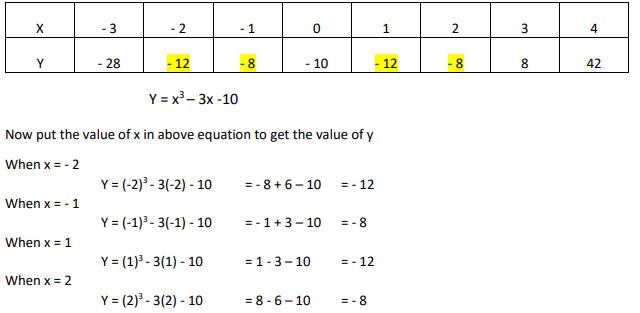
Now draw a graph according to the above-completed table:
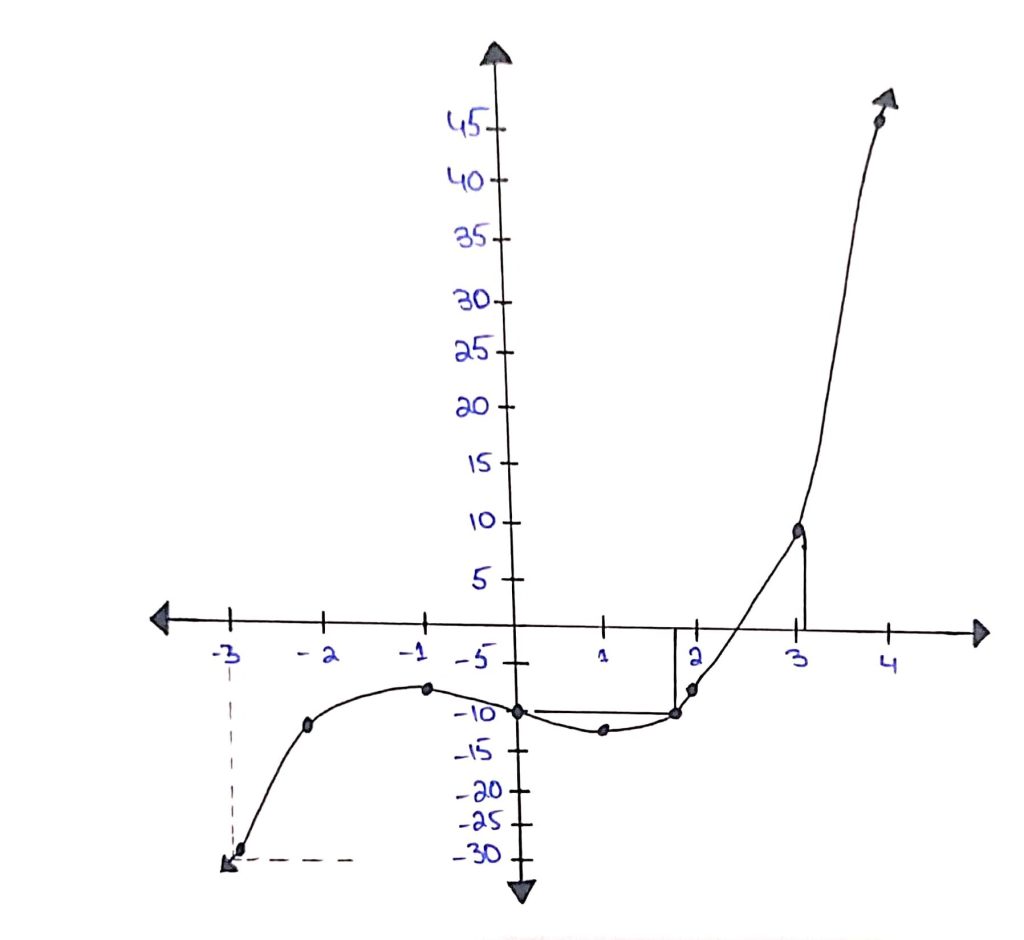
(D) Mr. Raheel invested Rs. 60,000 in an account that earns simple interest at the end of five years, the investment is worth Rs. 85000. Calculate the rate of simple interest per year.
Answer:
This question was taken from the Simple Interest Unit, in which we were required to calculate the rate of interest per year.
According to the question statement:
Principle amount = Rs.60,000
Time Period = 5 Years
Amount including interest after 5 years = Rs. 85,000
Simply find the interest earn on the principle amount
Interest = Amount after 5 years – principle amount
Interest = 85,000 – 60,000 = Rs.25,000
Now use the following formula for calculating the Interest rate per year;
Simple interest = Principal amount ∗ Interest rate ∗ time/100
25,000=(60,000 x R x 5)/100
(25,000 x 100)/60,000 x 5 = R
R= 25/3
Interest rate (R) = 8.33 % per year
Question – 08
(A) This question is taken from the jumbled word Unit in which we required to find the correct word
Answer:

(B) This question was taken from the Geometry Unit in which we required to find the triangles in given shapes
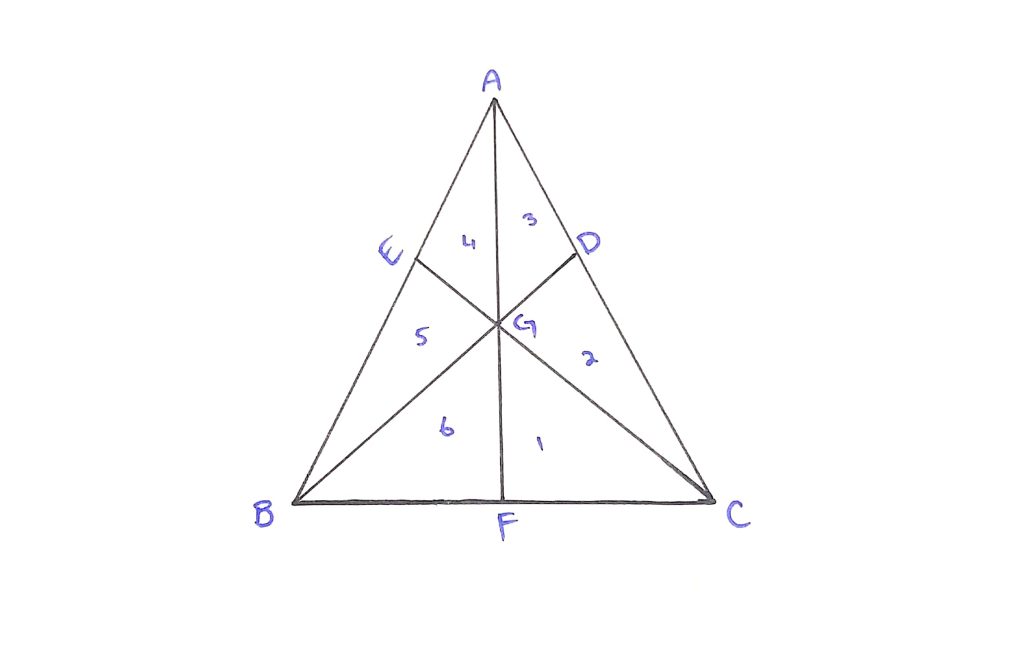
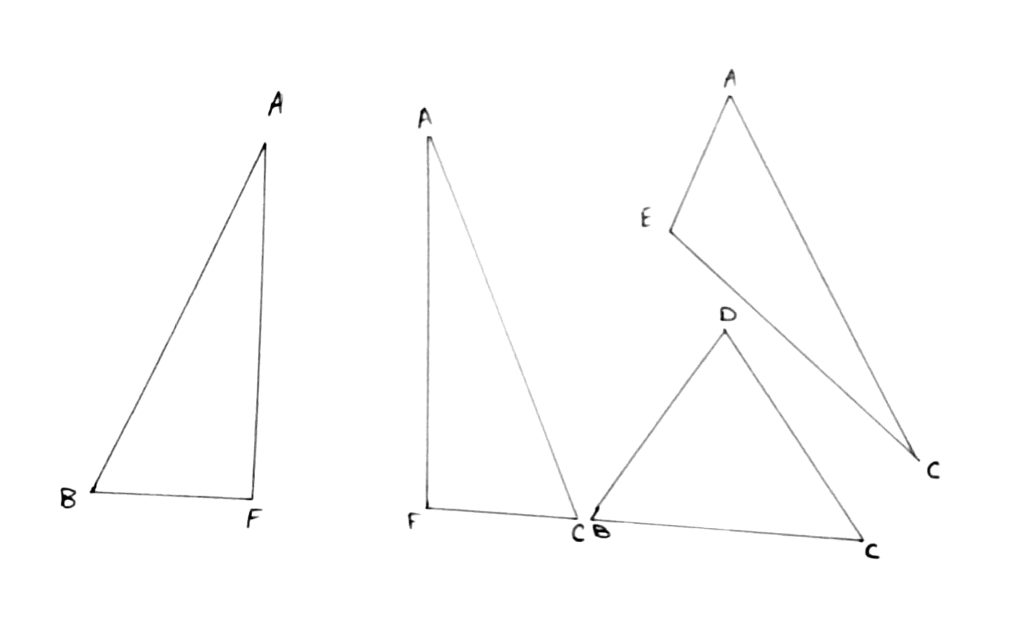
So, if we total triangles from above (fig. 1. And 2.), it will become 10 triangles.
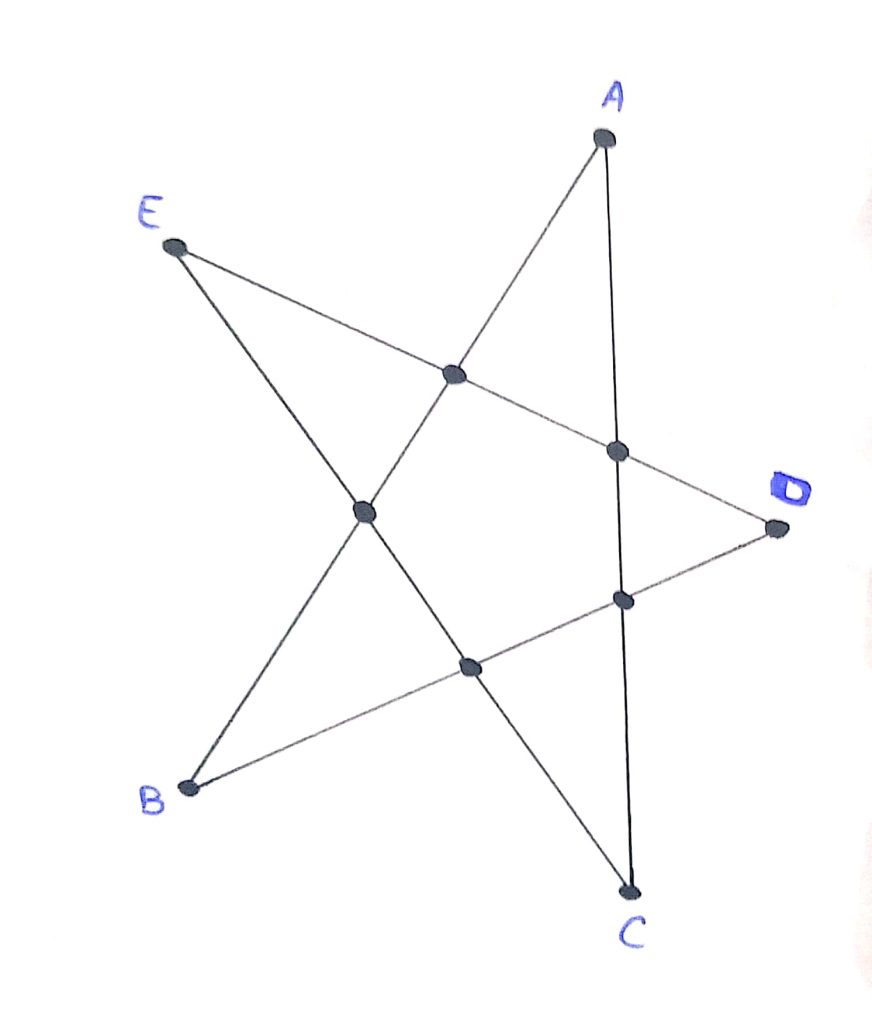
So, if we total the above, it will become 6 triangles
Total Triangles = 10 + 6 = 16.
(C) This question was taken from the Geometry Unit in which we required to calculate the area and perimeter of the given shape.
Answer
For calculating the area use following formula: Area = Length * Width
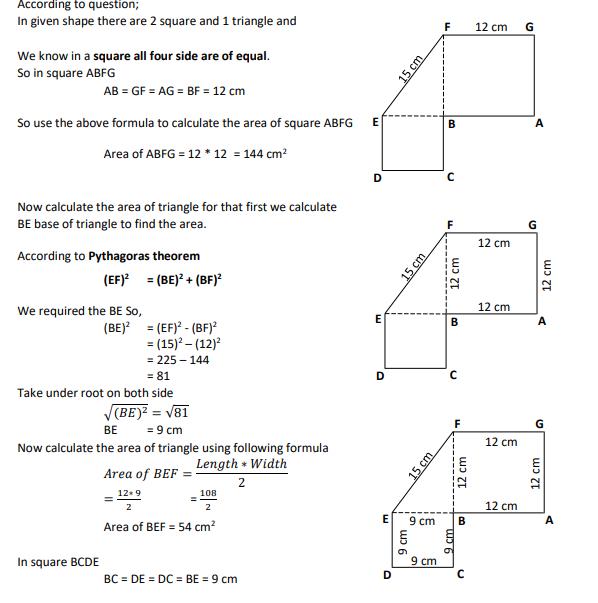

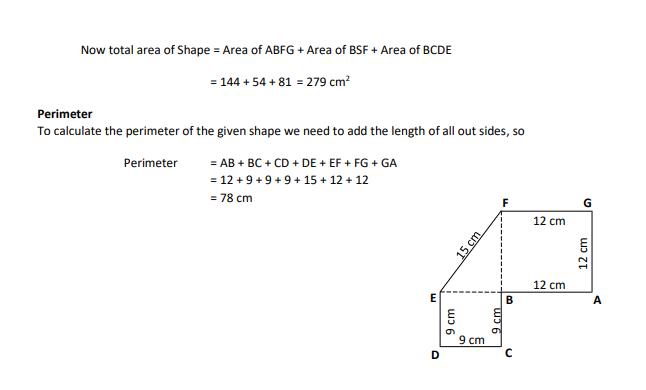
(D) This question was taken from the number series Unit in which we required to find the missing figures.
Answer:
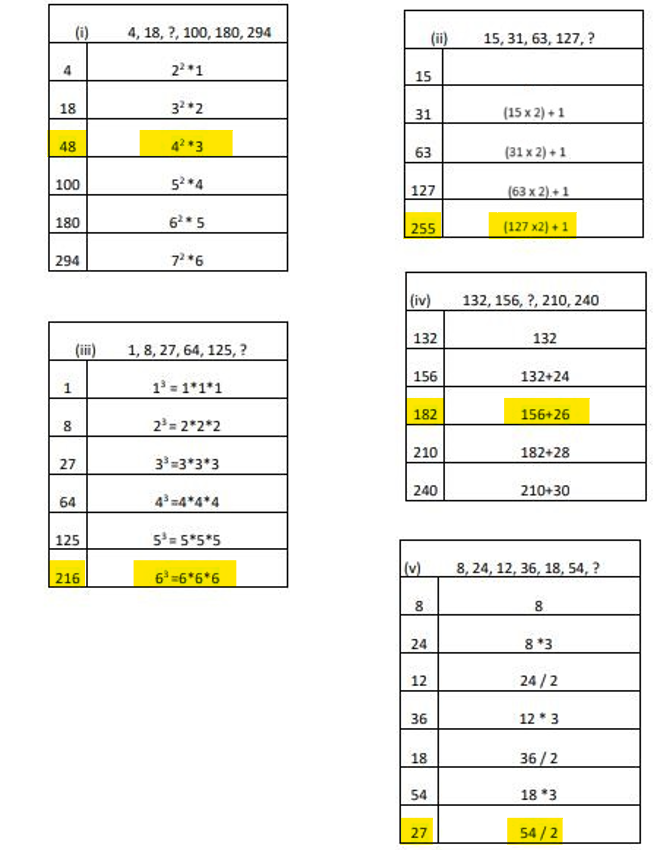
CSS Solved Past Papers’ Essays
Looking for the last ten years of CSS and PMS Solved Essays and want to know how Sir Kazim’s students write and score the highest marks in the essays’ papers? Then, click on the CSS Solved Essays to start reading them.
CSS Solved Essays

CSS Solved General Science & Ability Past Papers
| 1- | CSS Solved General Science And Ability Past Paper 2023 |
| 2- | CSS Solved General Science And Ability Past Paper 2022 |
| 3- | CSS Solved General Science And Ability Past Paper 2021 |
| 4- | CSS Solved General Science And Ability Past Paper 2020 |
| 5- | CSS Solved General Science And Ability Past Paper 2019 |
| 6- | CSS Solved General Science And Ability Past Paper 2018 |
| 7- | CSS Solved General Science And Ability Past Paper 2017 |
| 8- | CSS Solved General Science And Ability Past Paper 2016 |
| 9- | CSS Solved General Science And Ability Past Paper 2015 |
| 10- | CSS Solved General Science And Ability Past Paper 2014 |
| 11- | CSS Solved General Science And Ability Past Paper 2013 |
| 12- | CSS Solved General Science And Ability Past Paper 2012 |
| 13- | CSS Solved General Science And Ability Past Paper 2011 |
| 14- | CSS Solved General Science And Ability Past Paper 2010 |
| 15- | CSS Solved General Science And Ability Past Paper 2009 |
| 16 | CSS Solved General Science And Ability Past Paper 2008 |
| 17- | CSS Solved General Science And Ability Past Paper 2007 |
| 18- | CSS Solved General Science And Ability Past Paper 2006 |
| 19- | CSS Solved General Science And Ability Past Paper 2005 |
| 20- | CSS Solved General Science And Ability Past Paper 2004 |
| 21- | CSS Solved General Science And Ability Past Paper 2003 |
| 22- | CSS Solved General Science And Ability Past Paper 2002 |
| 23- | CSS Solved General Science And Ability Past Paper 2001 |
| 24- | CSS Solved General Science And Ability Past Paper 2000 |
Articles Might Interest You!
The following are some of the most important articles for CSS and PMS aspirants. Click on any to start reading.












